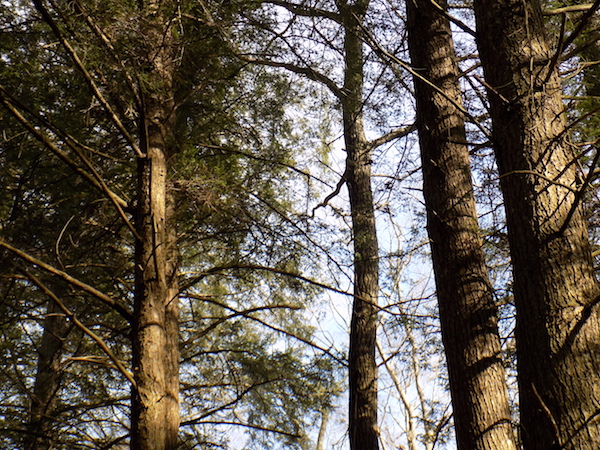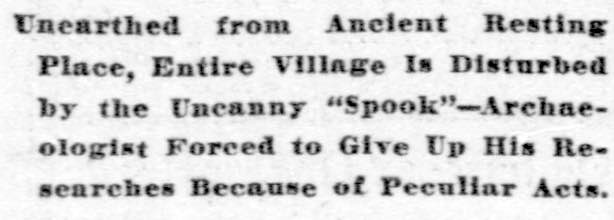
Whenever a long deceased body is removed from its grave, there are always those who believe the soul of the disturbed will haunt the living, such as in this old, 1906 case involving a Druid priestess.
Druid Priestess Haunts Despoilers of Her Grave
Bones Have to be Restored

An ancient skeleton that refused to abide peacefully in any abode but her original burial place, and after upsetting a whole village had to be taken back to her “barrow,” sounds like an old wives’ tale, yet it is a true story, and happened in no earlier time than our own prosaic twentieth century – to be more exact, on Saturday last – and in an ordinary English village in Wiltshire. The skeleton was that of a venerable British woman who reigned as high priestess of the Temple of Avebury, famous for its Druidical remains, some 4,000 years ago.
In the south of England are many of these barrows. They resemble large, grassy mounds, and were made by the natives of Britain thousands of years ago for their sepulchers. Many of them have been explored, and old weapons, ornaments, and domestic vessels have been found in them keeping company with the bones of their owners.
One of these barrows near the little village of Wedhampton, in Wiltshire, was explored last week, and in it were found a large number of very valuable gold ornaments. With these lay a woman’s skeleton, computed by the archaeologist who discovered it to be 4,000 years old. This rare treasure he decided to remove, and the ancient dame was carefully taken to a farmhouse near by, and placed in a room by herself. Next morning the terrified inhabitants came hurriedly to the man who have placed her there and implored him to take her away at once.
Priestess is Angry
It seems that as soon as darkness fell the old lady began strenuously to object to the disrespect which had been shown to her venerable bones, and from the room where she lay came the clatter of the most fearful shiny ever heard. All kinds of horrible noises proceeded from it, and the farmer and his family were unable to sleep the whole night.
Thinking this was probably more due to superstition than anything else, the skeleton was once more removed and placed in the house of Dr. Maurice, in the same village. And that night the noise was repeated, only ten times worse. It sounded to the frightened listeners outside as if a fearful struggle were going on, and the next morning when they went into the room, there were marks that resembled bloodstains on the walls.

Many other strange occurrences had also happened. The archaeologist’s bicycle had disappeared, and a search high and low in all parts of the house and garden proved fruitless. Also a gold bracelet, which had been on the wrist of a lady in the house for eight years, and which she had never once taken off in that time, had gone, and could be found nowhere.
Several more attempts were made to house the skeleton, but with the same alarming results, so the archaeologist decided that the only thing to be done was to restore her to her original resting place, which was eventually done. On returning to the barrow they found the bicycle and the bracelet.
Career of the Skeleton
Here is the career of the skeleton and its accompanying “spook” since the disinterment, in chronological order:
Saturday – Unearthed, put on a tea tray and carried to the house of Mr. Bucknam, in Marlborough.
Sunday morning (3:30) – Weird noises outside Mr. Bucknam’s house.
Monday – Continuation of peculiar noises.
Tuesday – Parts of the skeleton taken to the house of another gentleman. Servants declare that the table silver turned the color of blood.
Wednesday – Ornaments taken by Mr. Cunnington to be mounted and identified. A gold bracelet belonging to a lady of the household lost. Town clock at Devizes stopped, and the chimes ceased to play until it was decided that the body should be reinterred in its old resting place.
Friday – Four “disinterred” teeth taken to be fitted in the jaw. On the following afternoon they were discovered on the dining room table of a house twelve miles away.
Tuesday – A letter received by a Devizes gentleman announcing that two mysterious fires had occurred in a house where some of the remains were stored.
The discovery was one of which the archaeologist, Mr. B. H. Cunnington, F.S.A. (Scotland), may well be proud. It is more than a century since the last bronze age remains, with gold ornaments, were unearthed in the county of Wiltshire. It was the desecrating spade and scientific brain of Mr. Cunnington’s grandfather that brought to light this archaeological marvel. But this later discovery is beyond everything that preceded it.
Person of Importance
“The richness of the ornaments indicated a person of great importance,” said Mr. Cunnington to your representative yesterday, “but an unusual circumstance is that, although a cinerary urn was found near at hand, no other bones were dug up. It was customary for groups of people to be interred together in those far off years.”
Mr. Bucknam detailed to a reporter the phenomenon that has followed his reception of the bones. “I awoke at 3:30 a.m.,” he said, “and heard a shrill, weird cry. I aroused my wife, who declared that it was the hooting of an owl. I replied that it was like the wail of a banshee. The sound was unusual.
“Noises were also heard on the following night. When some dogs were sent out to investigate, one of them made straight for a shed in which the remains reposed and howled dismally.”
“I am a scientific man,” said Mr. Cunnington, “and I do not attempt to account for any of these things. From a scientific point of view the ‘find’ is interesting. The rest I leave to the psychologists. The incident of the teeth is certainly remarkable.”
Source: The Washington herald. (Washington, D.C.), 25 Nov. 1906.

